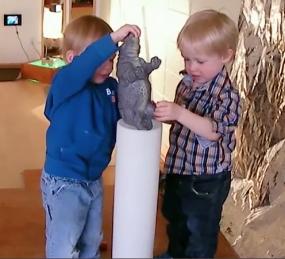Too Big

In this video clip, toddlers engage in size estimations and enjoy testing limits by creating conditions where one object very nearly fits inside another. Ben and Henry enjoy determining what toys fit inside a large tube stood on one end. The toddlers are engaging in mathematical thinking by estimating, or comparing the size of the tube’s opening to the size of each toy they select. Math play becomes the basis of their spontaneous game. As the video begins, the boys discover that a toy elephant does not fit fully inside the tube. Ben says, “It too big” (00:01). He then tries to put a second elephant inside the tube, and Henry says, “That’s too big” (00:08). This use of the comparative ("too big") says more than, "That's big." Henry has addressed the connection between what the relation is (big) to what the relation needs to be (smaller), an early form of logical-mathematical thinking. As teachers, it is helpful to examine what specific features of the play capture the children’s interest. Notice that the boys are using visual estimation to select toys that are similar in size to the opening of the tube. They do not, for example, choose the tiny red cylinder that is resting on the floor. Ben and Henry enjoy the tension they create when a toy nearly fits inside the tube. The boys are playing with an “almost but not quite” event. These toddlers have learned that there is a certain dissonance between visual estimation and physical accuracy (what nearly fits). The children exploit this new discovery by recreating these “almost but not quite” conditions in their play. What other materials could support children’s investigation of things that appear to fit but don’t quite? In what other ways might you invite children to explore the threshold of limits such as maximum and minimum?
Length of video: 1 minute 10 seconds
Keywords: Ones, Replica Toy, Child-Child, Math, Estimation, spatial relations
